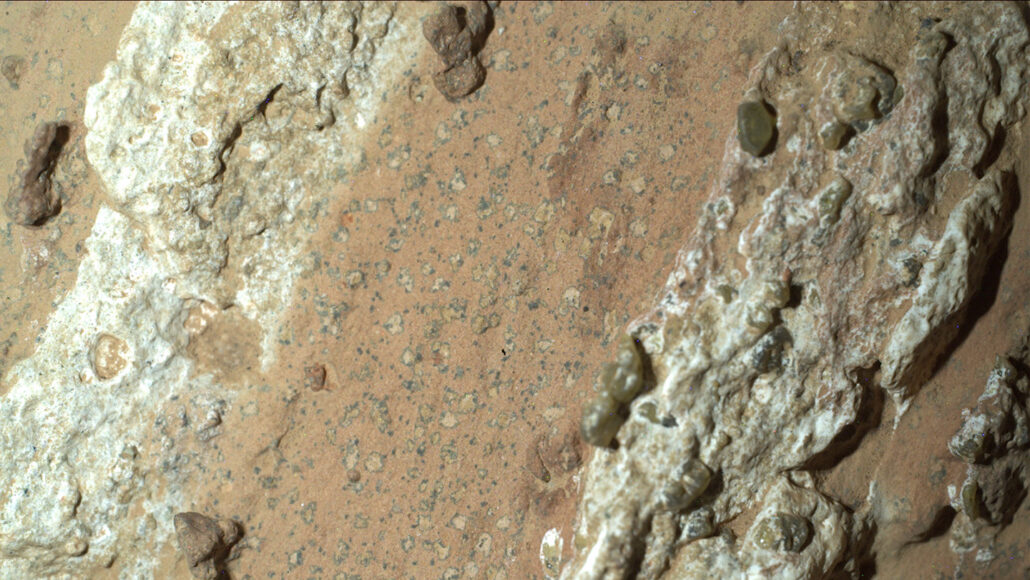‘Percy,’ NASA’s rover, finds its first hint of ancient life on Mars
This strengthens the case for bringing pieces of Mars back to Earth for closer study

The Mars Perseverance rover examined this rock on July 21. It found leopard spot–like features speckling clay-colored parts of it. These resemble structures in Earth rocks that have been linked to microbial life.
MSSS/JPL-Caltech/NASA
NASA’s Perseverance rover has bagged its first hint of ancient Martians. If they existed, these creatures were small. Very small. As in, microbes.
“We’re not able to say that this is a sign of life,” says Katie Stack Morgan. “But this is the most compelling sample we’ve found yet.” Morgan is the deputy project scientist in charge of the Mars rover. She works at NASA’s Jet Propulsion Lab in Pasadena, Calif.
Nicknamed Percy, the rover turned up this potential sign of life in mid-July. The robot had drilled into a reddish rock at a site known as Cheyava Falls. (It was named for a feature at the Grand Canyon.) This is the first piece of Mars that Percy found containing organic molecules. Here, the term organic refers to carbon-based molecules. On Earth, they’re the building blocks of life.
Project scientist Ken Farley shared Percy’s discovery July 25 at the 10th International Conference on Mars in Pasadena. Farley works at the California Institute of Technology there.
This isn’t the first sign of organics on Mars. The Curiosity rover detected organic molecules in 2014. It had been examining rocks at a site called Gale Crater. But since Percy landed in Jezero Crater three years ago, scientists have struggled to identify organics, Stack Morgan says. That landing site was an ancient, dried-up lake.
Adding to the new excitement, little white spots with black rims speckle the reddish rock sample that Percy found. “They look like a tricolored leopard spot,” Stack Morgan says.
Percy examined these spots using instruments that can identify the chemical recipe of materials. And the spots’ rims contained iron phosphate. On Earth, rings with similar texture and chemistry have been linked to ancient microbial life. The chemical reactions that create such rings can be an energy source for microbes.
To exist, those rings “don’t require life,” Stack Morgan says. And that’s an important point. “But based on our experience with similar things on Earth,” she says, “there is a possibility that life could have been involved.” So, Stack Morgan concludes, “these could have a biological origin.”
But other features of the sampled rock seem to muddy the picture of how it likely formed. For instance, Stack Morgan notes, it’s shot through with white veins of calcium sulfate. And those veins are filled with super-tiny crystals of olivine. It’s a mineral that forms from a volcano’s magma.
Finding the spots and these volcanic features in the same rock is “a little bit mysterious,” Stack Morgan says. They seem to point to different origins, she says. Going forward, figuring out how the rock formed could help tell how likely it is to have had the right conditions and temperatures to have once hosted life.

Signs of life on Mars? A few reasons for caution
Paul Byrne works at Washington University in St. Louis, Mo. And this planetary scientist thinks we should be cautious in interpreting Percy’s new findings.
“Could this truly be a [signature of life]?” he asks. “Yes. And if it is, then it really is the kind of society-altering discovery that the discovery of truly extraterrestrial life would be.” But it’s also possible, he notes, that the spots came from something other than life. In that case, he notes, “All this is, is an interesting example of water-rock chemistry.”
The only way to find out for sure is to bring the rock home. A big part of Percy’s mission is to collect samples from interesting rocks for a future spacecraft to later bring home to Earth. Once here, they can be studied with better tools than a rover can carry on its back. For now, Stack Morgan says, Percy has thrown everything it has at this rock.
When might the rocks be brought to Earth? No one knows. Funding is currently on hold for a program known as Mars Sample Return, or MSR. “With this sample, the rationale for MSR is strengthened,” Byrne says. He hopes it will “motivate NASA to commit to … this project sooner rather than later.”
Stack Morgan says the rover team is carrying on despite MSR’s iffy budget.
“We have a mission to carry out and a job to do,” Stack Morgan says — collecting compelling samples. “It can only be our hope that the samples that we collect are compelling enough to justify the cost of Mars Sample Return.”
And she thinks Percy’s exciting new sample “really hits that home.”







